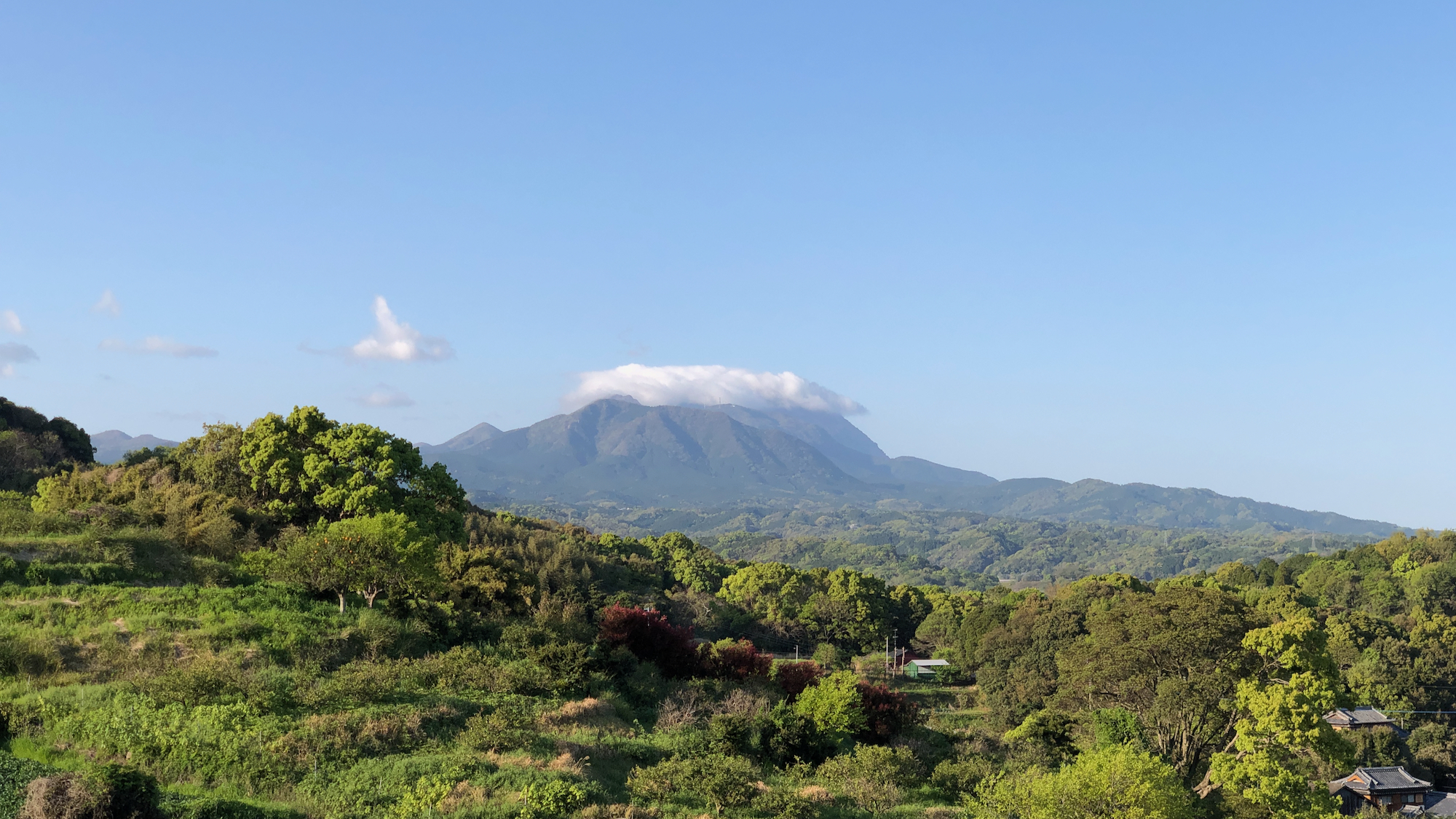From a tiny speck on the horizon, the volcano slow grew as I crossed first the mud flats of Kumamoto and then the shallow waters of the Ariake Sea. Now, at the foot of the volcano, looming over the small city of Shimabara, there was only one way to go: up!
Unzen, the central volcano of the Shimabara peninsula, is actually a volcanic complex with a number of peaks. Fugen-dake (普賢岳) was the highest peak of the mountain until 1990 when the eruption mentioned last time saw a new peak jut out a further 127 meters. This is Heisei-shinzan (平成新山) — the “new mountain.”

In a rental car from Shimabara I started out on the gentle green slopes of farmland, the road occasionally bending back upon itself until I got to the mountain proper. The narrow road then became closed in with cedar trees on either side. Fog and cloud further obscured the twisty road up the side of the volcano complex.

I was not trying to summit the volcano, but rather spend some time at a small village nestled in a crevice partway up where the heart of the volcano deep underground pushes heated water up to the Unzen Hot Springs. Fissures also exist on both the east and west side of the peninsula, in the seaside communities of Shimabara and Obama respectively. Although the source is the same, the mineral makeup of each hot springs area is varied enough that the waters feel different in each of the places — or so I was told ¯\_(ツ)_/¯
Unzen hot springs are above the fog and clouds, but there was a scant break in visibility as soon my vision was obscured by sulphurous steam as I pulled into the mountain village. The windows were already rolled up tight but that eggy smell got in anyways. However, it did not take long to get used to.
Still too early for check-in, I took a few minutes to drive the main road through town. It wends through the village on the way further up the mountain to the peaks. An area with a few cross-crossing streets offers tourists a place to buy souvenirs or a snack. The village is very hilly, and bisected by ashen hot springs fields, gushing out plumes of steam. I would return here for a leisurely sulphurous stroll after checking in. But first, I wanted to go check out a historical spot of interest.

The Unzen Kankō Hotel is one of a series of classical hotels built in a Western style to attract Western tourists during the Meiji Period up to the Second World War. Nagasaki Port had quite the head-start during Japan’s early internationalization, and had links to other treaty ports in Asia. There were also more and more European foreigners residing in Japan. As early as 1865 there were around 150 foreigners in Nagasaki city, half of them British, including the famous Thomas Blake Glover. (Glover’s son Tomisaburo Kuraba cofounded Nagasaki’s Naigai Club, an internationalist organization for promoting Japanese-Western relations, and actually built the first golf course on Unzen.) After the turn of the 20th century there were thirty-six Western saloons and nineteen hotels service foreign travellers in Nagasaki.


The Unzen Kankō Hotel was set up in 1934 and catered to foreigners at different ports in Japan like Tokyo and Kobe, but also at nearby ports like Shanghai and Dalian. The weather up the mountain is much cooler than the sweaty valleys of Nagasaki city, so Unzen became a welcome retreat to Brits in their Victorian clothing. Escaping the coal mines and industrialized shipyards of Nagasaki for some “fresh” mountain air, taking a dip in the restorative hot springs, and relaxing in a facility with thick carpets, claw-footed bathtubs, a billiards table and library stocked with books from all over Europe seems pretty attractive for both turn-of-the-century Westerners and Japanese of the time.





I actually had reservations at another place (a more traditional Japanese onsen hotel), but I wanted to have a look at the Unzen Kankō and get a feel for its history. The place was empty, being in the middle of the pandemic, so the front desk staff were quick to oblige any request. I asked them some very specific historical questions, and assuming (correctly) I was some sort of weird enthusiast, they quickly offered me a tour of one of the rooms. I took out my camera and followed the concierge up the wide wooden staircase. She showed me the rooms, opened up the balconies, pointed out some of the hand-made Taisho-Roman furniture and fittings, and basically let me have the run of the place. I had a coffee in the lounge and perused the gift shop, imagining what it would be like to take a steamer around the cape from Nagasaki to Obama (4 1/2 hours according to Murray’s 1894 guidebook), then a jinrikisha up the side of the volcano to stay at a place like this for a month or so to “restore my delicate constitution.” What a strange time.
After having my fill of old-timey colonialist luxury, I took a wander around the expansive, gurgling, and steaming jigoku, or ”hells.” Steam billowed in masses as I walked along the bricked path, meandering through the ashen fields of hot springs. Stray cats were everywhere, stretched out and enjoying the geothermally-heated pavement. In fact, they were right up on the rocks, enjoying the warmth!



It was quite a long stroll. Over a number of rises the path climbs to the top of a hill where you can get a heavily obscured view of the small valley, dotted with multi-storied hotels servicing the bus tours.
Past the topmost landing, a back-path takes you up to another rise that is more forested, with a large rocky area above the pools of boiling water. Here I stumbled upon a monument to martyred Christians (see this short video walkthrough).

As part of the religious oppression resulting in the Christian uprising called the Shimabara Rebellion in the early seventeenth century, thirty-three Christians were tortured to death here in an attempt to stamp out foreign influence. The country was subsequently closed off to most European visitors until the era of “classic” hotels like the Unzen Kankō. Unfortunately for the Unzen Kankō, the Second World War was a damper on Western tourism, forcing it to close for a time.
But now, if you want a nice place to escape the Nagasaki heat, climb the volcano in the center of the Shimabara peninsula and you too can enjoy such back-and-forth history and some lovely hot springs.


